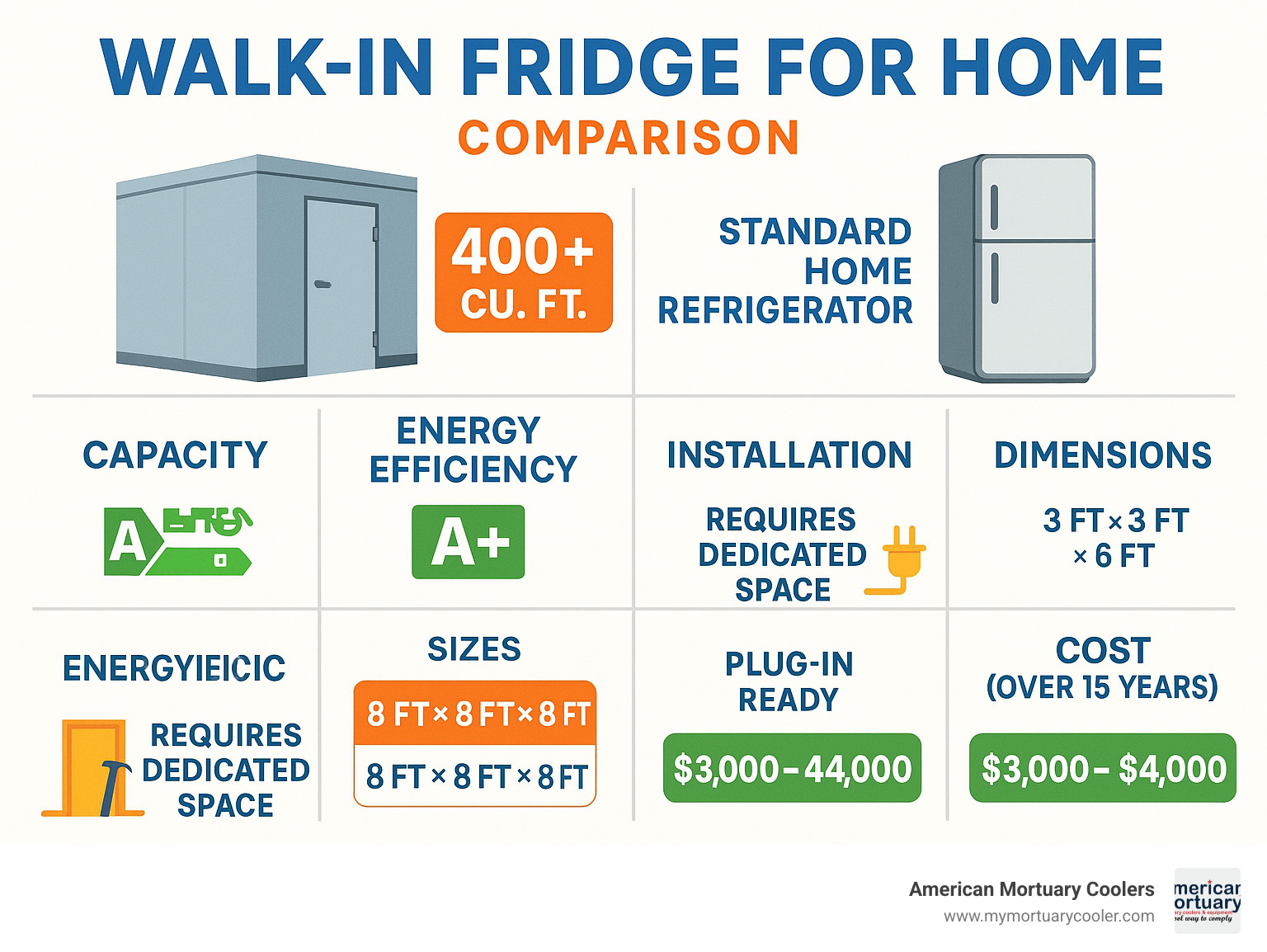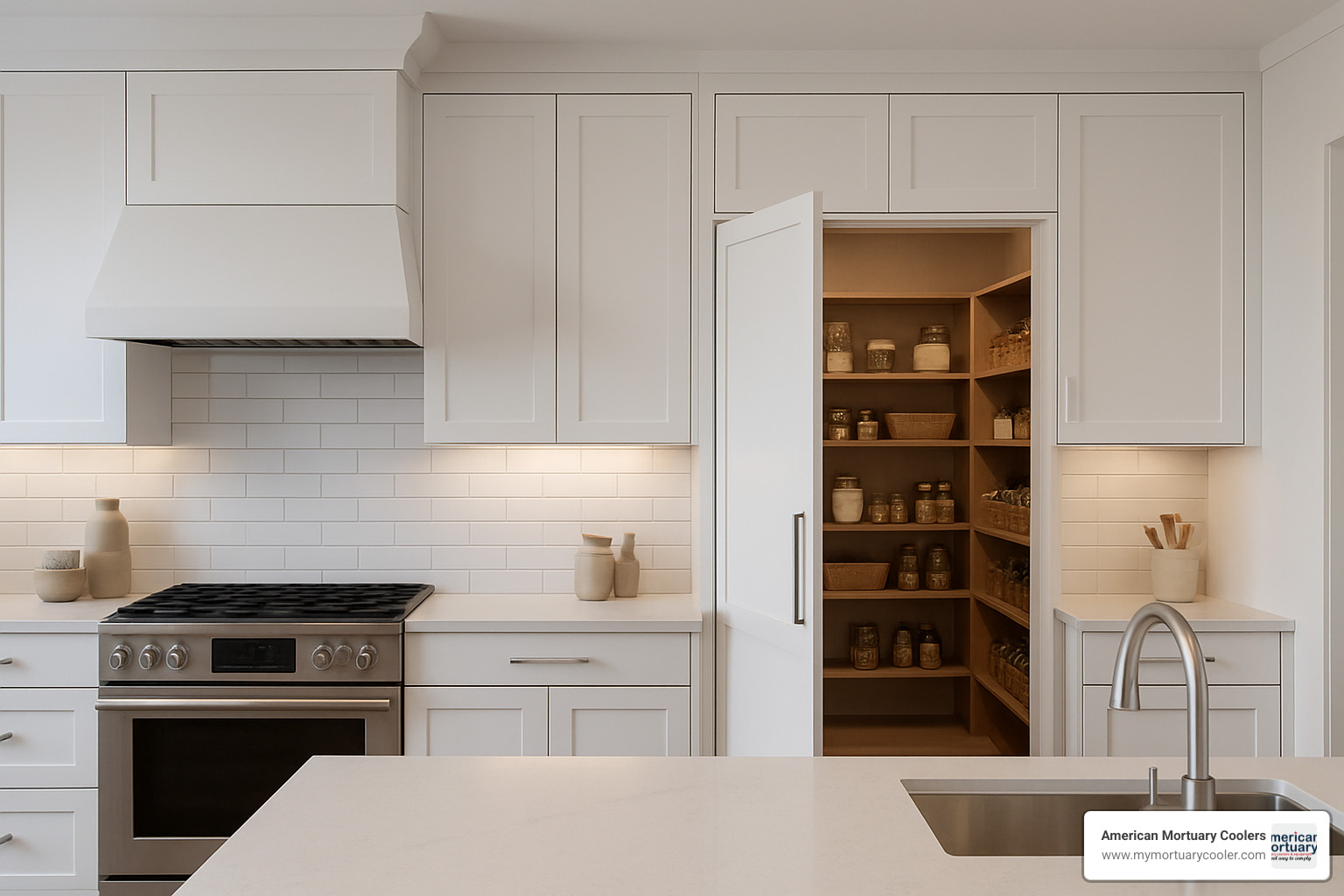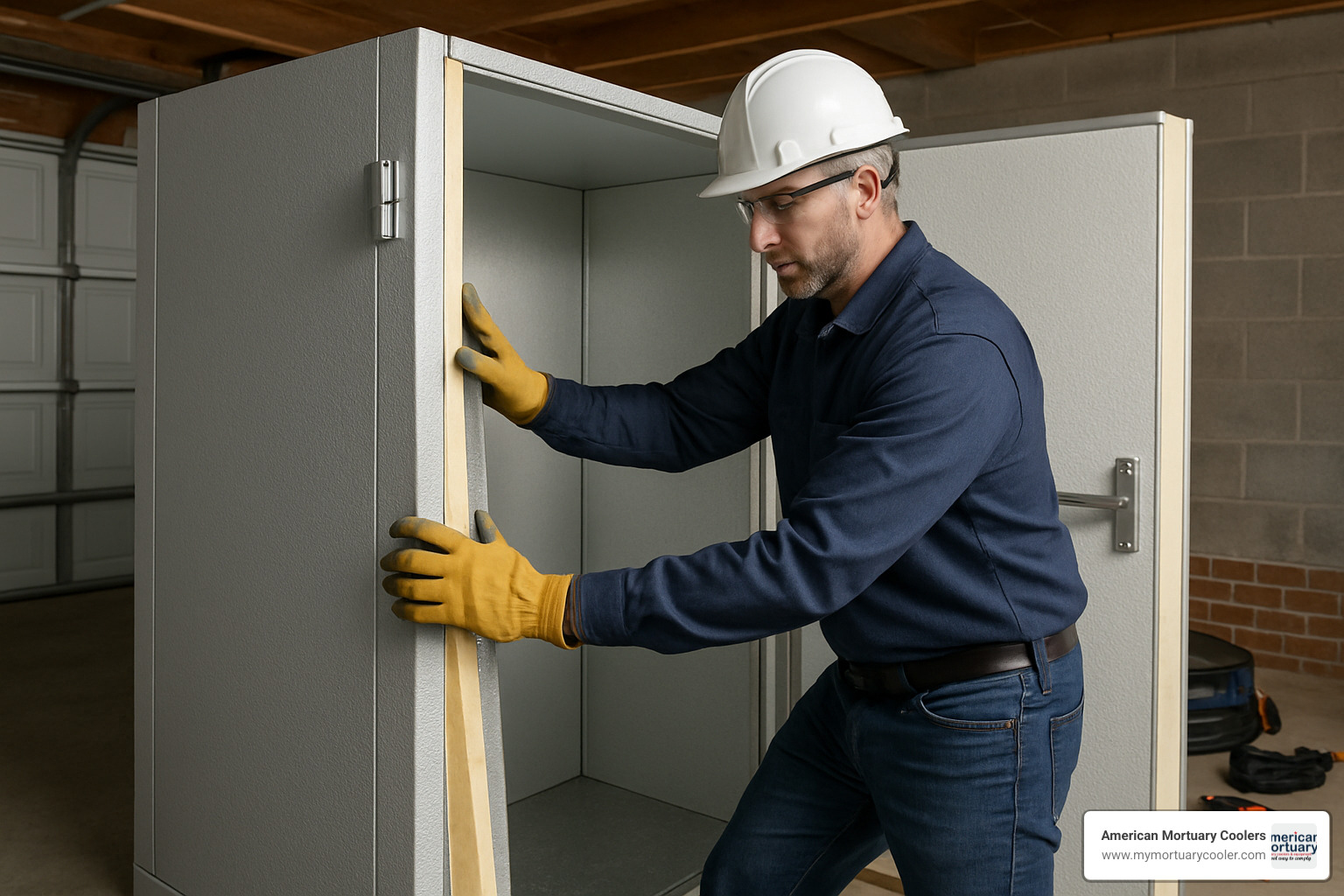
Beginner's Guide to Choosing a Walk-In Fridge for Your Home
Why Walk-In Fridges Are Revolutionizing Home Storage
A walk in fridge for home is a luxury refrigeration solution that offers 20 times more storage space than traditional refrigerators - typically providing 400+ cubic feet of capacity compared to just 20 cubic feet in standard home fridges.
Quick Facts About Walk-In Home Fridges:
- Storage: 400+ cubic feet (vs. 20 cubic feet for standard fridges)
- Cost: $10,000-$15,000 including installation
- Savings: Up to $500/year in energy costs vs. multiple standard fridges
- Lifespan: 15-25 years with proper maintenance
- Space Required: Minimum 5'×5' area, can be built in basements, garages, or converted pantries
- Features: Dual-temperature zones, glass viewing doors, app monitoring, custom shelving
The trend toward residential walk-in refrigeration is exploding. Modern families are embracing bulk shopping, entertaining larger groups, and seeking the ultimate luxury kitchen upgrade.
These units aren't just oversized fridges - they're sophisticated climate-controlled rooms that can function as refrigerators, freezers, or dual-zone combinations. They integrate seamlessly into home design, often disguised as pantries or featured as stunning glass-door showcases.
I'm Mortuary Cooler, a national-level supplier specializing in custom cooling solutions including residential walk in fridge for home installations. With years of experience in precision refrigeration systems, I've helped countless families transform their food storage and entertaining capabilities through expertly designed walk-in cooling solutions.

Walk in fridge for home further reading:
What Is a Walk-In Fridge for Home Use?
Think of a walk in fridge for home as your own personal grocery store cooler, but designed to blend seamlessly into your home. It's essentially a refrigerated room that gives you restaurant-level storage without sacrificing the comfort and style you want in your living space.
These aren't just oversized appliances - they're sophisticated climate-controlled spaces that typically offer around 400 cubic feet of storage capacity. That's enough room to walk in, browse your food like you're shopping, and store everything from party platters to bulk purchases without playing refrigerator Tetris.
Modern residential walk-in fridges work as pantry-style coolers that can maintain different temperature zones within the same unit. The magic happens through remote-compressor technology, which keeps the noisy mechanical parts away from your living space.
How a walk in fridge for home differs from a traditional refrigerator
Storage volume is the most obvious difference. While your standard home fridge gives you about 20 cubic feet to work with, walk-in units start at 400 cubic feet and can go much larger. That's literally 20 times more space.
The air circulation systems are in a completely different league. Traditional fridges use basic fans that create hot and cold spots. Walk-in units use sophisticated airflow technology that keeps temperatures consistent throughout the entire space.
Insulation thickness is where things get really interesting. Walk-in fridges use 4-inch thick panels with serious insulation ratings, compared to the much thinner walls in standard appliances. This means better temperature control and lower energy costs over time.
Walk in fridge for home vs. walk-in freezer vs. dual-zone combos
A walk-in refrigerator keeps everything between 35-40°F - perfect for fresh produce, dairy, leftovers, and beverages. Walk-in freezers operate at 0°F or below for long-term frozen storage.
Dual-zone combinations give you the best of both worlds. These convertible units let you customize how much space you dedicate to refrigeration versus freezing. You can even switch sections between modes as your needs change throughout the year.
Why Upgrade? Key Benefits & Stand-Out Features
Picture this: you're hosting Thanksgiving dinner, and instead of cramming everything into an overstuffed refrigerator, you simply walk into your own walk in fridge for home and grab whatever you need. No more playing refrigerator Tetris or storing drinks in coolers outside.
The bulk storage capability alone makes these units game-changers. You can store entire cases of beverages, multiple party platters, and those massive grocery hauls from warehouse stores without breaking a sweat.
The superior food preservation means your groceries actually last longer. The consistent temperature control and proper air circulation keep everything at the perfect temperature, reducing food waste and saving you money over time.
Visual organization is another huge win. Unlike traditional fridges where items disappear into dark corners, walk-in units give you clear sight lines to everything.
From a financial perspective, a well-designed walk in fridge for home adds significant resale value to your property.
Innovations to look for in 2024
QFlow 360™ air systems use patent-pending airflow technology to eliminate those annoying hot spots. Every corner of your walk-in stays at the perfect temperature.
Smart monitoring through systems like SmartSleeve™ sensors means you can check and adjust temperatures from your phone. Imagine getting an alert if the temperature fluctuates while you're at work.
Glass viewing doors are becoming incredibly popular. These insulated glass panels let you see everything inside without opening the door, which keeps temperatures stable while showing off your impressive food collection.
The remote refrigeration pods (rPod™) are brilliant for home use. They move the noisy compressor 10-15 feet away from your cold room, so you get near-silent operation in your living space.
Energy efficiency & running costs
Despite their impressive size, modern walk in fridge for home units can actually save you money on electricity.
The secret lies in advanced insulation. These units use R-29 to R-32 insulation ratings, which means they hold their temperature much better than multiple standard refrigerators running at once.
Variable speed technology means the compressors and fans only work as hard as they need to. Instead of constantly running at full power like older systems, they adjust based on demand.
Homeowners typically save around $500 per year on energy costs compared to running multiple standard fridges. Over a 15-year lifespan, that's $7,500 back in your pocket.

Planning Your Space & Design Integration
Planning for a walk in fridge for home is like designing a small room – because that's exactly what you're doing! The key is finding the sweet spot between functionality and fitting seamlessly into your home's flow.
Most families find that while the minimum footprint is 5'×5', going with an 8'×10' space feels much more comfortable. You'll want room to move around comfortably, especially when carrying large platters or cases of beverages.
Your home probably has several spots that could work beautifully. Garage conversions are incredibly popular. Basements offer natural coolness and often have the ceiling height needed. Even that oversized pantry or spare room could become your family's new favorite space.

Typical sizes & storage capacities
The standard 1200mm depth (about 4 feet) works perfectly because it matches most kitchen cabinetry.
Compact 6'×8' units work well for smaller homes. The popular 8'×10' modules hit the sweet spot for most families. If you're serious about entertaining or have a large family, 10'×12' or larger installations give you restaurant-level storage capacity.
Modular kits offer another approach – you can start smaller and expand later as your needs grow.
Aesthetics: blending into cabinetry or making a statement
Your walk in fridge for home can either disappear completely or become the star of your kitchen. The integrated approach uses custom doors that match your existing cabinetry, making the unit virtually invisible until you step inside.
Split-unit noise control solves one of the biggest concerns about home installations. The compressor can live in your garage, basement, or utility room while the actual cold space stays whisper-quiet.
Lighting schemes transform the experience from utilitarian to luxurious. LED systems can provide bright task lighting for finding items quickly, or create dramatic showcase effects.
Customization & flexibility
Every walk in fridge for home should feel like it was designed specifically for your family's needs. U-shelving configurations maximize storage along three walls, while specialized wine racks keep your collection at perfect temperatures.
The smartest families think about future adaptability from the start. Modular designs let you reconfigure shelving, add new features, or even expand the space later.
More info about custom solutions
Budget, Energy & Installation Considerations
Let's talk money - because I know that's what you're really wondering about when considering a walk in fridge for home. The good news? While the upfront investment feels substantial, the long-term value often surprises homeowners.
You're looking at roughly $10,000 for a complete custom setup, including professional installation. Yes, that's significantly more than the $1,500 you'd spend on a standard fridge. But you're not just buying a bigger refrigerator. You're investing in a system that replaces multiple appliances, lasts 15-25 years, and can actually save you money over time.
Professional installation is typically your best bet for most homeowners. The electrical work, refrigeration connections, and proper sealing require expertise to ensure everything works safely and efficiently.
For the handy folks out there, CoolBot systems offer a DIY-friendly alternative. These clever devices let you convert an insulated room using a standard air conditioner, cutting costs significantly if you're comfortable with the technical aspects.
The return on investment comes from multiple angles - energy savings of around $500 annually, reduced food waste, and increased home value.
Walk-In Coolers That Won't Freeze Your Budget
Comparing upfront vs. lifetime costs
When you compare the total cost of ownership over 15 years, walk-in fridges become much more attractive:
| Option | Initial Cost | Annual Energy | 15-Year Total | Capacity |
|---|---|---|---|---|
| Two Standard Fridges | $3,000 | $400 | $9,000 | 40 cu ft |
| Multiple Mini-Fridges | $2,000 | $600 | $11,000 | 30 cu ft |
| Walk-In Fridge | $10,000 | $180 | $12,700 | 400+ cu ft |
Note: Walk-in provides 10x more storage capacity with only slightly higher lifetime costs
The installation process step-by-step
Installing your walk in fridge for home follows a logical progression that typically takes 2-3 days with professional crews.
Site preparation comes first - clearing and leveling your chosen area, ensuring proper ventilation, and verifying that your electrical system can handle the load.
Panel assembly is where things get exciting. The modular panels go up according to manufacturer specifications, with careful attention to sealing and structural integrity.
Refrigeration hookup involves connecting refrigeration lines, installing the condensing unit, and commissioning the entire system.
Do you need a pro? When DIY makes sense
Most homeowners benefit from professional installation, especially for electrical work and refrigeration connections. Complex custom designs, structural modifications, and warranty protection all favor the professional route.
DIY options do exist for the mechanically inclined. CoolBot kits work well for converting existing insulated spaces, and some modular panel systems come with detailed instructions for simple installations.
My recommendation? Unless you have solid HVAC experience, invest in professional installation. The peace of mind and warranty protection are worth the extra cost.

Lifespan, Maintenance & Sustainability
When you invest in a walk in fridge for home, you're making a decision that will serve your family for decades. These units are built to last significantly longer than traditional refrigerators, with most providing reliable service for 15-25 years with proper care.
Compare that to standard home refrigerators, which typically need replacement after 10-13 years, and you start to see the real value proposition.
Keeping your system running smoothly requires some attention, but nothing too demanding. Monthly gasket cleaning keeps seals tight and energy costs down. Every few months, you'll want to clean the condenser coils.
The most important maintenance step is annual professional service. A qualified technician will check refrigerant levels, calibrate temperature controls, and catch any small issues before they become expensive problems.
Potential drawbacks & challenges
Let's be honest - a walk in fridge for home isn't right for every situation. The biggest hurdle for most families is simply having adequate space. You need both floor area and sufficient ceiling height, which can be challenging in smaller homes or condos.
The upfront investment is substantial. While the lifetime value often justifies the cost, that initial $10,000+ price tag requires serious budget planning.
Humidity management can be tricky, especially in basement installations. Poor ventilation leads to condensation problems that can damage your home and reduce the unit's efficiency.
Power outages present unique challenges with larger units. While a standard fridge might keep food cold for several hours during an outage, a walk-in unit holds much more food at risk.
Environmental impact & future-proofing
Modern walk in fridge for home units are surprisingly environmentally responsible, especially considering their size. Manufacturers have adopted natural refrigerants with much lower global warming potential than older systems used.
Advanced insulation technology provides superior temperature retention while using fewer raw materials. These panels are so effective that some units achieve better energy efficiency per cubic foot than standard refrigerators.
Perhaps the biggest environmental benefit is reduced food waste. Better organization, consistent temperatures, and ample storage space mean families throw away less spoiled food.
Scientific research on energy-saving refrigeration
Frequently Asked Questions about walk in fridge for home
Let's address the most common questions I hear from homeowners considering a walk in fridge for home installation.
How much space do I really need?
While you can squeeze a walk in fridge for home into a 5'×5' area, you'll be happier with more room to move around.
I typically recommend starting with at least 8'×10' if your space allows. This gives you enough room to actually walk in comfortably, organize your storage properly, and access items without feeling cramped. You'll also need adequate ceiling height - usually 8 feet minimum.
Think about your family's habits when planning size. Do you buy groceries in bulk from warehouse stores? Host large dinner parties? A family of four who entertains regularly will use space very differently than empty nesters who prefer intimate gatherings.
Are there portable or modular options I can start with?
Absolutely! This is actually a smart approach if you're not ready to commit to a full custom installation right away.
CoolBot systems are probably your best entry point. These clever devices let you convert any well-insulated room or shed into a walk-in cooler using a standard window air conditioner. The whole setup costs under $1,000 if you already have an insulated space.
Modular panel systems offer another flexible option. These come as pre-made insulated panels that bolt together like an adult LEGO set. If you move or want to reconfigure later, you can disassemble and relocate the entire unit.
The beauty of starting smaller is that many of these systems can be expanded later. You might begin with a simple CoolBot setup in your garage, then upgrade to a full custom walk in fridge for home once you've proven the concept works for your family.
What safety features protect kids and pets?
Safety is absolutely critical with any walk in fridge for home installation, and thankfully, modern units include multiple layers of protection.
Interior safety releases are the most important feature. These handles work from inside the unit even if someone accidentally locks the door from outside. They're designed to be easily operated by children and are typically bright colored or glow-in-the-dark for visibility.
Self-closing hinges prevent the dangerous scenario of doors accidentally swinging shut while someone's inside. These hinges are calibrated to close gently but reliably.
Interior lighting with exterior switches means you can always see inside clearly, and family members outside know when someone's in the unit. Some systems include motion sensors that automatically illuminate the space when someone enters.
The key is working with experienced installers who understand residential safety requirements.
Conclusion
Choosing a walk in fridge for home isn't just about getting more storage space - it's about completely changing how your family approaches food, entertaining, and daily life. With 400+ cubic feet of capacity compared to a standard fridge's 20 cubic feet, these units solve the frustrating puzzle of cramped refrigerator space once and for all.
The numbers speak for themselves: annual energy savings of $500, a 15-25 year lifespan that outlasts multiple standard refrigerators, and the kind of organized, accessible food storage that makes meal planning and entertaining genuinely enjoyable. When you factor in reduced food waste, bulk shopping savings, and the sheer convenience of seeing everything at a glance, the investment makes practical sense.
But beyond the practical benefits, there's something deeply satisfying about opening the door to your own cold sanctuary - whether you're grabbing ingredients for dinner, preparing for a holiday gathering, or showing off your impressive setup to guests.
At American Mortuary Coolers, we've spent years perfecting precision refrigeration systems. Now we're bringing that same custom craftsmanship and attention to detail to residential applications. Our team understands that your walk-in fridge needs to work seamlessly with your home's design while delivering reliable, whisper-quiet performance year after year.
Direct delivery across the contiguous 48 states means we can serve homeowners from our Tennessee base to California and everywhere in between. We're not just selling equipment - we're partnering with you to create a refrigeration solution that fits your space, your needs, and your vision perfectly.
Whether you're tired of playing refrigerator Tetris every time you grocery shop, dreaming of effortless entertaining, or planning a kitchen that truly works for your family's lifestyle, a walk in fridge for home might be exactly what you've been looking for.
Ready to take the next step? Explore more at our blog for detailed guides, real customer stories, and expert insights that'll help you plan your perfect refrigeration upgrade.



